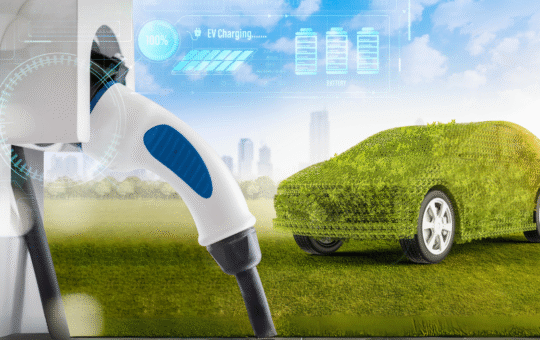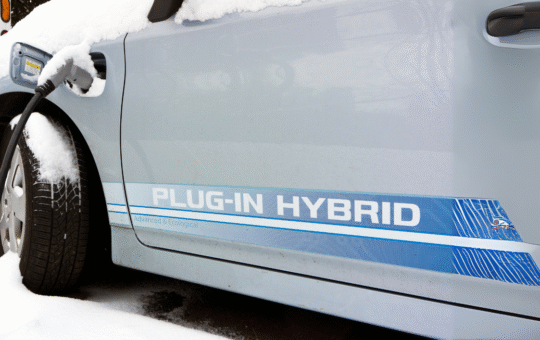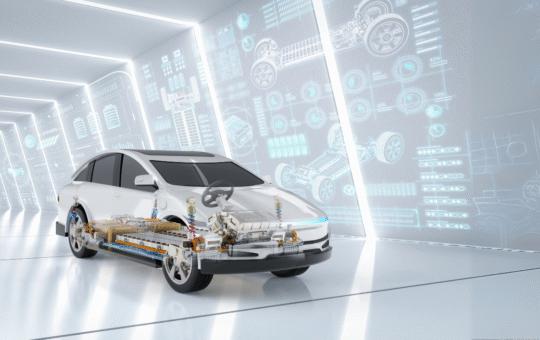
Level 6 Diploma in Advanced Autonomous and Connected Vehicle Systems
- Gain specialized knowledge in autonomous vehicle systems, including sensors, algorithms, and vehicle control.
- Learn about the design and implementation of vehicle connectivity technologies such as V2V, V2I, and 5G communication networks.
- Develop expertise in the integration of AI and machine learning techniques in autonomous driving.
- Enhance career prospects with a qualification in one of the most dynamic and innovative areas of the automotive industry.
- Understand the key technologies behind autonomous and connected vehicles, including sensors, AI, and communication systems.
- Learn how to design, program, and optimize autonomous driving systems, including perception, decision-making, and control.
- Gain proficiency in implementing vehicle connectivity technologies and ensuring seamless communication between vehicles and infrastructure.
- Develop expertise in the challenges of safety, security, and regulation associated with autonomous and connected vehicles.
- Introduction to Autonomous Vehicle Systems
- Overview of autonomous driving levels (from Level 0 to Level 5).
- Key components of autonomous vehicles: sensors (LiDAR, radar, cameras), control units, and software systems.
- Vehicle-to-Vehicle (V2V) and Vehicle-to-Infrastructure (V2I) Communication
- Study of V2V and V2I communication technologies and standards, including DSRC, 5G, and V2X.
- How connected vehicles exchange data with other vehicles and infrastructure to improve safety and traffic efficiency.
- Advanced Sensors and Perception Systems for Autonomous Vehicles
- In-depth analysis of sensor technologies such as LiDAR, radar, cameras, and ultrasonic sensors.
- How sensors collect and process environmental data for perception and decision-making in autonomous vehicles.
- Autonomous Driving Algorithms and AI
- Machine learning and deep learning techniques used for vehicle perception, path planning, and decision-making.
- Development of algorithms for real-time object detection, obstacle avoidance, and adaptive driving strategies.
- Vehicle Control Systems and Automation
- Study of the control systems that enable autonomous vehicles to navigate safely and efficiently.
- How to integrate AI-driven decision-making with real-time vehicle dynamics and actuation systems.
- Cybersecurity and Safety in Autonomous Vehicles
- Addressing the cybersecurity challenges faced by autonomous and connected vehicles.
- Ensuring vehicle safety through redundancy, fault tolerance, and secure communication protocols.
- Legal, Ethical, and Regulatory Considerations
- Understanding the legal frameworks and regulations governing autonomous and connected vehicles.
- Ethical considerations in autonomous driving, including decision-making in emergency situations and data privacy.
- Future Trends in Autonomous and Connected Vehicle Technologies
- The evolution of self-driving technology and its potential impact on transportation systems.
- Emerging technologies such as 5G, vehicle platooning, and the integration of autonomous vehicles into smart cities.
- Pursue advanced qualifications in autonomous vehicle technology, connected vehicle systems, or smart mobility (e.g., Master's in autonomous systems or robotics).
- Work as an autonomous vehicle systems engineer, connected vehicle developer, or AI specialist in the automotive or tech industries.
- Specialize in developing autonomous driving technologies, vehicle connectivity systems, or vehicle cybersecurity in R&D, manufacturing, or policy-making roles.
- State-of-the-Art Curriculum: Learn about the cutting-edge technologies driving the future of autonomous and connected vehicles.
- Hands-On Learning: Gain practical experience in developing autonomous systems and vehicle communication technologies through simulations and projects.
- Expert Instruction: Learn from instructors with extensive experience in autonomous systems, AI, and automotive R&D.
- Globally Recognized Certification: Enhance your career prospects with a qualification valued by leading automakers, tech companies, and regulatory agencies.
Study Units
- Introduction to Autonomous Vehicle Systems
- Overview of autonomous driving levels (from Level 0 to Level 5).
- Key components of autonomous vehicles: sensors (LiDAR, radar, cameras), control units, and software systems.
- Vehicle-to-Vehicle (V2V) and Vehicle-to-Infrastructure (V2I) Communication
- Study of V2V and V2I communication technologies and standards, including DSRC, 5G, and V2X.
- How connected vehicles exchange data with other vehicles and infrastructure to improve safety and traffic efficiency.
- Advanced Sensors and Perception Systems for Autonomous Vehicles
- In-depth analysis of sensor technologies such as LiDAR, radar, cameras, and ultrasonic sensors.
- How sensors collect and process environmental data for perception and decision-making in autonomous vehicles.
- Autonomous Driving Algorithms and AI
- Machine learning and deep learning techniques used for vehicle perception, path planning, and decision-making.
- Development of algorithms for real-time object detection, obstacle avoidance, and adaptive driving strategies.
- Vehicle Control Systems and Automation
- Study of the control systems that enable autonomous vehicles to navigate safely and efficiently.
- How to integrate AI-driven decision-making with real-time vehicle dynamics and actuation systems.
- Cybersecurity and Safety in Autonomous Vehicles
- Addressing the cybersecurity challenges faced by autonomous and connected vehicles.
- Ensuring vehicle safety through redundancy, fault tolerance, and secure communication protocols.
- Legal, Ethical, and Regulatory Considerations
- Understanding the legal frameworks and regulations governing autonomous and connected vehicles.
- Ethical considerations in autonomous driving, including decision-making in emergency situations and data privacy.
- Future Trends in Autonomous and Connected Vehicle Technologies
- The evolution of self-driving technology and its potential impact on transportation systems.
- Emerging technologies such as 5G, vehicle platooning, and the integration of autonomous vehicles into smart cities.
Upon completing this diploma, learners will:
- Understand the key technologies behind autonomous and connected vehicles, including sensors, AI, and communication systems.
- Learn how to design, program, and optimize autonomous driving systems, including perception, decision-making, and control.
- Gain proficiency in implementing vehicle connectivity technologies and ensuring seamless communication between vehicles and infrastructure.
- Develop expertise in the challenges of safety, security, and regulation associated with autonomous and connected vehicles.
This diploma is tailored for individuals seeking to advance their careers in the transformative fields of autonomous driving and connected vehicle technologies. It is particularly suitable for:
Autonomous Vehicle Engineers
Professionals involved in the design, development, and testing of self-driving vehicle systems, including perception, decision-making, and control technologies.
AI and Machine Learning Specialists in Automotive
Engineers and developers applying artificial intelligence, deep learning, and machine learning techniques to enhance autonomous vehicle performance, perception, and decision-making.
Connected Vehicle and V2X Engineers
Individuals working on Vehicle-to-Everything (V2X) technologies, including V2V (Vehicle-to-Vehicle), V2I (Vehicle-to-Infrastructure), and V2C (Vehicle-to-Cloud) communication systems.
Automotive Cybersecurity Professionals
Specialists focused on ensuring the safety and security of data and systems in connected and autonomous vehicles, protecting against potential vulnerabilities and cyber threats.
Systems Engineers and R&D Experts
Engineers involved in the research and integration of multi-domain technologies—such as sensor fusion, automation, control systems, and telecommunications—into smart mobility solutions.
Regulatory and Policy Advisors
Professionals supporting the development of frameworks for legal, ethical, and regulatory standards governing autonomous and connected vehicle operations.
Graduates and Technicians in Automotive and Mechatronics Engineering
Aspiring individuals aiming to specialize in autonomous driving technologies, vehicle connectivity, and AI-driven automotive innovation at an advanced academic and technical level.
Our assessment process is designed to ensure every learner achieves the required level of knowledge, skills, and understanding outlined in each course unit.
Purpose of Assessment
Assessment helps measure how well a learner has met the learning outcomes. It ensures consistency, quality, and fairness across all learners.
What Learners Need to Do
Learners must provide clear evidence that shows they have met all the learning outcomes and assessment criteria for each unit. This evidence can take different forms depending on the course and type of learning.
Types of Acceptable Evidence
Assignments, reports, or projects
Worksheets or written tasks
Portfolios of practical work
Answers to oral or written questions
Test or exam papers
Understanding the Structure
Learning outcomes explain what learners should know, understand, or be able to do.
Assessment criteria set the standard learners must meet to achieve each learning outcome.
Assessment Guidelines
All assessment must be authentic, current, and relevant to the unit.
Evidence must match each assessment criterion clearly.
Plagiarism or copied work is not accepted.
All learners must complete assessments within the given timelines.
Where applicable, assessments may be reviewed or verified by internal or external quality assurers.
Full learning outcomes and assessment criteria for each qualification are available from page 8 of the course handbook.
Top Courses
No results found.
Related Courses
Let's Get in touch
Deleting Course Review
Course Access
This course is password protected. To access it please enter your password below:



